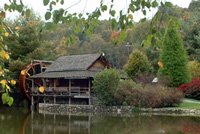One of the first considerations for greenhouse cooling is to decide what you will be growing. The necessity for greenhouse cooling may increase depending on the things you plan to grow. Once your greenhouse temperature exceeds 85 degrees F, some plants may be stressed from the excessive heat. Your greenhouse cooling requirements may also depend on the climate you live in. If you live in a cooler climate you may not have a concern with greenhouse cooling until summer arrives. (from The Greenhouse Catalog)
LEARNING OBJECTIVES
- Review the basic principles of greenhouse ventilation and cooling.
- Discuss advantages and disadvantages of different cooling systems
fan and pad
passive cooling
active cooling
winter cooling
summer cooling
polytube
HAF
Chlorine/Bromine injector
excelsior
cellulose
fog
relative humidity
sling psychrometer
evaporation
ventilator
cfm
elevation
light intensity
temperature gradient
exhaust fan
READING ASSIGNMENT
- Read pages 153-183 in the textbook.
- Read NGMA cooling hints
- Explain why disease incidence may be higher in a greenhouse with a pad-and-fan cooling system than one with fog cooling? (5 pts)
- Why is necessary to have a convection tube for air distribution for active winter cooling systems where you plan to use the cooler outside air on those sunny bright winter days? (5 pts)
- When the area of cooling pads needed is calculated by a greenhouse designer the thickness of the cooling pad to be used is important to know. For example when a 6" pad is used only 66% of the total square footage of pads is needed as when 4" thick pads are used. Why is this the case? (5 pts)
- How do HAF fans assist with active winter cooling? (5 pts)
- Describe the major components of a pad-and-fan cooling system and explain the role of each. (15 pts)
- Why is a chlorine/bromine injector important to maximize the functional life of the cooling pads? (5 pts)
- Why is water quality much more critical in a fog cooling system than in a pad-and-fan cooling system? (5 pts)
- One future system that engineers have suggested would be spraying fog directly into existing pads in pad-and-fan systems. What parts of the system you described in question 5 might you be able to eliminate? (5 pts). Do you think this would eliminate the temperature gradient that exists with current pad-and-fan cooling systems? (5 pts).
- Conditions for workers are of greater concern now than ever before. What are two advantages of fog cooling systems for employees that spend long hours in the greenhouse? (10 pts).
Watch Microlecture Cooling 1 Now
Watch Microlecture Cooling 2 Now
- Watch both microlectures.
- Review calculations for greenhouse cooling on your own. I expect you to know what factors are important and why? For example the role that light intensity, elevation, and allowable temperature rise play in the greenhouse, but you will not be responsible for the direct calculation in this course.
- Go to the following website http://www.kwangu.com/work/psychrometric.htm and determine the wetbulb temperature for the following scenarios: (TWB = Wetbulb Temperature at the website) You will have to convert between metric and English units Calcoolate.com is a great site you should bookmark.
Tucson, AZ 98 F, 27
Clyde, NC 92 F, 59
Fort Pierce, FL 84 F, 77
Based on what you learned in the microlectures answer the following questions based on the above scenario for July 28th, 2007:
- What is the wetbulb temperature for the given dry bulb temperture and RH at each location? (15 points)
- If the same greenhouse was constructed at all 3 locations which one could achieve the lowest tempterature given the scenario above if the greenhouses were equipped with pad-and-fan cooling (5 pts).
- What would be the lowest temperature possible for the clyde location on this day (correct for pad-and-fan) system? (5 pts)
- What would be the lowest temperature possible for the Clyde location and scenario if a fog cooling system was installed? (5 pts)
- Explain why the lowest temperature possible at the Fort Pierce and Clyde locations is essentially the same on this particular day with these conditions? Afterall it is 8 F cooler in Fort Pierce due to Ocean breezes. (5 pts)
- ice description of some cooling system possibilities for greenhouses from IGC. No endorsement given or implied.
- Good description of commercial fog system advantages from TRUE FOG USA. No endorsement given or implied.
- Univeristy of Florida article on greenhouse design for Humid Hot Environments. Check out the Cooling Section.
Switching careers is never easy. See the road one grower took. Watch the 'Starting A New Business'



No comments:
Post a Comment